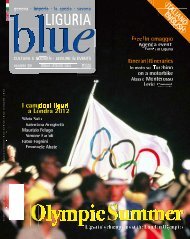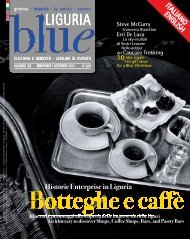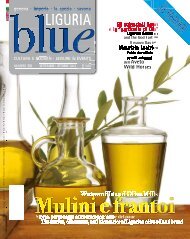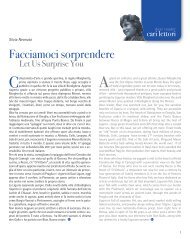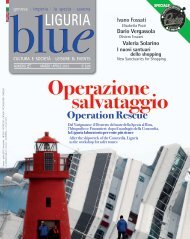Download PDF - Blue Liguria - Sagep
Download PDF - Blue Liguria - Sagep
Download PDF - Blue Liguria - Sagep
You also want an ePaper? Increase the reach of your titles
YUMPU automatically turns print PDFs into web optimized ePapers that Google loves.
lue interview<br />
Vietti - coordinatore con Luigi<br />
Carlo Daneri del gruppo di<br />
progettisti genovesi della Casa<br />
d’acciaio, presentata in occasione<br />
della V Triennale di Milano del<br />
1933 - progettò alcuni celebri<br />
arredi, caratterizzati da una<br />
peculiare sintesi formale tra le<br />
impostazioni razionaliste del<br />
Bauhaus e l’organicismo di Alvar<br />
Aalto. E non bisogna dimenticare,<br />
nel contesto progettuale del<br />
dopoguerra, i rigorosi allestimenti<br />
di Franco Albini per il patrimonio<br />
museale genovese o il progetto di<br />
Ponti per la sedia Superleggera,<br />
ispirata alle famose chiavarine.<br />
Sempre negli anni Trenta, grazie<br />
al sodalizio tra Marinetti e Tullio<br />
Mazzotti, le manifatture di<br />
ceramica di Albisola diedero<br />
invece vita a una dinamica e<br />
innovativa produzione futurista<br />
che penetrò anche, con la sua<br />
dirompente carica estetica, nella<br />
produzione della S.A.V. (Società<br />
Artistica Vetraria) di Altare, la<br />
quale alternò, nella prima metà<br />
del Novecento, prodotti seriali (la<br />
famosa bottiglia della “gazzosa<br />
con la biglia”) con monumentali<br />
opere da esposizione o piccole<br />
serie d’artista, come i bicchieri di<br />
Alma Fidora presentati alla VI<br />
Triennale di Milano del 1936.<br />
Anche la Mita (Manifattura<br />
Italiana Tappeti Artistici), fondata<br />
nel 1927 a Genova Nervi da<br />
Mario Alberto Ponis e da lui<br />
diretta sino al 1970, affidò il<br />
design dei suoi tappeti a un<br />
futurista, Fortunato Depero,<br />
avviando poi un’intensa<br />
collaborazione con artisti come<br />
Arturo Martini e con gli architetti<br />
Ponti, Buzzi e Lancia e<br />
rinnovando quindi nel<br />
dopoguerra la sua attività,<br />
attraverso la produzione di tessuti<br />
stampati in serigrafia su disegno<br />
di Borella, Scanavino, Arnaldo<br />
Pomodoro, Sottsass Jr., Paulucci,<br />
Costantini e Carmi. Quest’ultimo<br />
fondò a Genova nel 1963, con<br />
Max Bill, Vasarely, Costantini,<br />
Luzzati, Dorfles, Celant, Beringheli<br />
Artistic New Arrangements),<br />
specializing in the production of<br />
ceramics, furniture, and textiles.<br />
In the same period, Luigi Vietti -<br />
coordinator with Luigi Carlo<br />
Daneri of the group of Genoese<br />
designers of the Steel House,<br />
Casa d’acciaio, making their<br />
debut on the occasion of the V<br />
Triennial of Milan in 1933 –<br />
designed some famous interiors<br />
characterized by a peculiar formal<br />
synthesis between the rational<br />
framework imposed by the<br />
Bauhaus and the organic<br />
architecture of Alvar Aalto. Also<br />
not to be forgotten, in the postwar<br />
context, are the rigorous<br />
designs by Franco Albini for the<br />
Genoese museum heritage or the<br />
project by Ponti for the superlight<br />
chair, the Superleggera,<br />
inspired by the famous Chiavarine<br />
chairs of Chiavari.<br />
During the thirties as well, thanks<br />
to the fellowship between<br />
Marinetti and Tullio Mazzotti, the<br />
Design ligure tra gli anni<br />
Venti e Trenta: il Salotto<br />
di Luigi Fontana & C e una<br />
sedia di Luigi Vietti<br />
<strong>Liguria</strong>n Design between<br />
the Twenties and Thirties:<br />
Salotto (Living Room) by<br />
Luigi Fontana & C, and a<br />
chair by Luigi Vietti<br />
e Minetti, la Galleria del Deposito<br />
che, avvalendosi di stampi<br />
industriali già predisposti per una<br />
produzione seriale, promosse la<br />
realizzazione di una serie di<br />
multipli, la cui rilevanza fu<br />
centrale all’interno del dibattito<br />
estetico degli anni Sessanta. Non<br />
a caso proprio a Genova inaugurò<br />
nel 1966 Eurodomus,<br />
manifestazione patrocinata dalla<br />
rivista “Domus” che, affiancando<br />
produzioni molto diversificate nel<br />
campo dell’arte e del design,<br />
propose, nelle sue quattro<br />
edizioni (le altre ebbero luogo a<br />
Milano e a Torino), una<br />
sperimentale presentazione<br />
dell’arredo per la casa.<br />
manufacturers of ceramics in<br />
Albisola, an innovative and<br />
dynamic Futurist production was<br />
brought to life which penetrated<br />
even – with its disruptive<br />
esthetics – into the production at<br />
S.A.V. (the Artistic Glass<br />
Company) of Altare, which<br />
alternated, in the first half of the<br />
1900s, between serial products<br />
(the famous bottle for “the soda<br />
with the marble”) and<br />
monumental exposition works or<br />
small artists’ series, like Alma<br />
Fidora’s glasses presented at the<br />
VI Triennial of Milan in 1936.<br />
Even the Mita (Italian<br />
Manufacturers Italy of Artistic<br />
Carpets) founded in 1927 in<br />
Genoa-Nervi by Mario Alberto<br />
Ponis and directed by him until<br />
1970, entrusted the design of its<br />
carpets to a Futurist, Fortunato<br />
Depero, thereby starting an<br />
intense collaboration with artists<br />
like Arturo Martini and architects<br />
like Ponti, Buzzi, and Lancia. This<br />
renewed activity after the war<br />
through the production of silkscreened<br />
textiles on the designs<br />
by Borella, Scanavino, Arnaldo<br />
Pomodoro, Sottsass Jr., Paulucci,<br />
Costantini and Carmi. Carmi<br />
founded in Genoa in 1963, with<br />
Max Bill, Vasarely, Costantini,<br />
Luzzati, Dorfles, Celant, Beringheli<br />
and Minetti, the Galleria del<br />
Deposito which through the use<br />
of industrial prints already set up<br />
for serial production, promoted<br />
the creation of a multiple series,<br />
whose relevance became central<br />
to the inside of the esthetic<br />
debate of the sixties. It was not a<br />
fluke that right here in Genoa in<br />
1966 Eurodomus was organized.<br />
This event, under the patronage<br />
of the magazine “Domus” which,<br />
alongside many diversified<br />
productions in the field of art and<br />
design, proposed, during the<br />
course of four years (the other<br />
events took place in Milan and<br />
Turin), an experimental<br />
presentation of furnishings for<br />
the home.<br />
46



